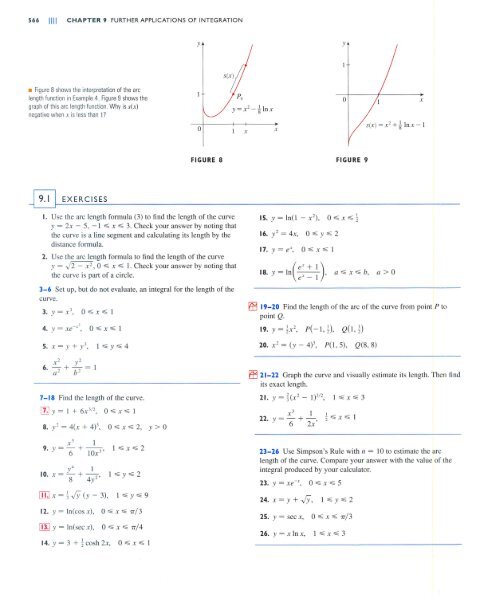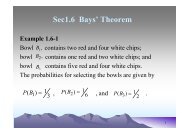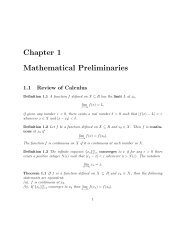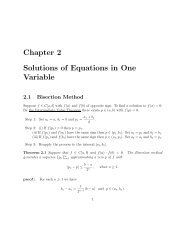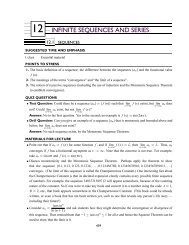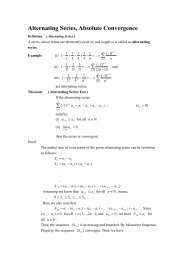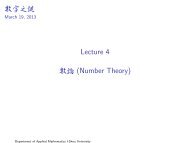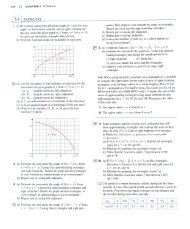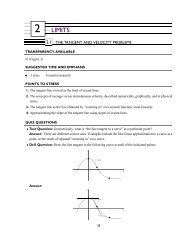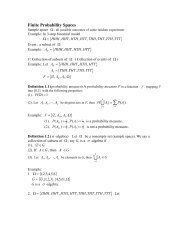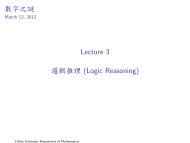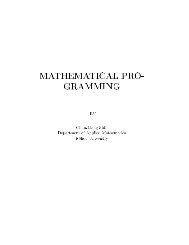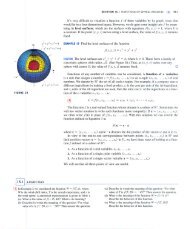[ill x = j .JY (y - 3),
[ill x = j .JY (y - 3),
[ill x = j .JY (y - 3),
You also want an ePaper? Increase the reach of your titles
YUMPU automatically turns print PDFs into web optimized ePapers that Google loves.
• Figure 8 shows the interpretation of the arc<br />
length function in Example 4. Figure 9 shows the<br />
graph of this arc length function. Why is s(x)<br />
negative when x is less than 1?<br />
§ EXERCISES<br />
'(X# Po<br />
I. Use the arc length formula (3) to find the length of the curve<br />
y = 2x - 5, -1 'S x 'S 3. Check your answer by noting that<br />
the curve is a line segment and calculating its length by the<br />
distance formula.<br />
2. Use the arc length formula to find the length of the curve<br />
y = ~, 0 'S x 'S I. Check your answer by noting that<br />
the curve is part of a circle.<br />
3-6 Set up, but do not evaluate, an integral for the length of the<br />
curve.<br />
7-18 Find the length of the curve.<br />
[I] y = I + 6X 3 / 2 , 0 'S x 'S I<br />
y4 I<br />
10. x = - + --0'<br />
8 4y-<br />
[<strong>ill</strong> x = j .<strong>JY</strong> (y - 3), 1 'S Y 'S 9<br />
12. y = In(cos x), 0 'S x 'S 71/3<br />
[!I] Y = In(sec x), 0 'S x 'S 71/4<br />
y =X 2<br />
- i lnx<br />
0 x x<br />
15. Y = In(1 - x 2 ), 0 'S x 'S ~<br />
16. y2 = 4x, 0 'S Y 'S 2<br />
eX + 1)<br />
18.y=ln<br />
(<br />
---, a'Sx'Sb,<br />
eX - 1<br />
ffi 19-20 Find the length of the arc of the curve from point P to<br />
point Q.<br />
19. y=~X2, p(-I,1), Q(I,1)<br />
20. x 2 = (y - 4)3, P(l, 5), Q(8,8)<br />
ffi 21-22 Graph the curve and visually estimate its length. Then find<br />
its exact length.<br />
21. y=~(X2 _1)3/2, I 'Sx'S 3<br />
x 3 1 I<br />
22. Y = - + - :2 'S X 'S I<br />
6 2x'<br />
23-26 Use Simpson's Rule with n = 10 to estimate the arc<br />
length of the curve. Compare your answer with the value of the<br />
integral produced by your calculator.<br />
23. y = xe- x , 0 'S X 'S 5
ffi 27. (a) Graph the curve y = x.y4 - x, 0'% X '% 4.<br />
(b) Compute the lengths of inscribed polygons with n = 1,2,<br />
and 4 sides. (Divide the interval into equal subintervals.)<br />
Illustrate by sketching these polygons (as in Figure 6).<br />
(c) Set up an integral for the length of the curve.<br />
(d) Use your calculator to find the length of the curve to four<br />
decimal places. Compare with the approximations in<br />
part (b).<br />
[<strong>ill</strong>] 29. Use either a computer algebra system or a table of integrals to<br />
find the exact length of the arc of the curve y = In x that lies<br />
between the points (I, 0) and (2, In 2).<br />
[<strong>ill</strong>] 30. Use either a computer algebra system or a table of integrals to<br />
find the exact length of the arc of the curve y = X 4 / 3 that lies<br />
between the points (0, 0) and (I, I). If your CAS has trouble<br />
evaluating the integral, make a substitution that changes the<br />
integral into one that the CAS can evaluate.<br />
~ Sketch the curve with equation X 2 / 3 + y2/3 = 1 and use symmetry<br />
to find its length.<br />
32. (a) Sketch the curve y3 = x 2 •<br />
(b) Use Formulas 3 and 4 to set up two integrals for the arc<br />
length from (0,0) to (I, 1). Observe that one of these is<br />
an improper integral and evaluate both of them.<br />
(c) Find the length of the arc of this curve from (-I, I)<br />
to (8, 4).<br />
[<strong>ill</strong> Find the arc length function for the curve y = 2X 3 / 2 with<br />
starting point Po (I , 2).<br />
ffi 34. (a) Graph the curve y = 5X3 + 1/(4x), x> O.<br />
(b) Find the arc length function for this curve with starting<br />
point Po( I, fz).<br />
(c) Graph the arc length function.<br />
35. Find the arc length function for the curve<br />
y = sin-I x + J1=7 with starting point (0, 1).<br />
36. A steady wind blows a kite due west. The kite's height above<br />
ground from horizontal position x = 0 to x = 25 m is given<br />
by y = 50 - 0.1 (x - 15)2. Find the distance traveled by<br />
the kite.<br />
37. A hawk flying at 15 m/s at an altitude of 180 m accidentally<br />
drops its prey. The parabolic trajectory of the falling prey is<br />
described by the equation<br />
x 2<br />
Y = 180 -- 45<br />
until it hits the ground, where y is its height above the ground<br />
and x is the horizontal distance traveled in meters. Calculate<br />
the distance traveled by the prey from the time it is dropped<br />
until the time it hits the ground. Express your answer correct<br />
to the nearest tenth of a meter.<br />
38. The Gateway Arch in St. Louis (see the photo on page 465)<br />
was constructed using the equation<br />
for the central curve of the arch, where x and yare measured<br />
in meters and I x I '% 91.20. Set up an integral for the length<br />
of the arch and use your calculator to estimate the length<br />
correct to the nearest meter.<br />
39. A manufacturer of corrugated metal roofing wants to produce<br />
panels that are 60 cm wide and 4 cm thick by processing flat<br />
sheets of metal as shown in the figure. The profile of the roofing<br />
takes the shape of a sine wave. Verify that the sine curve<br />
has equation y = 2 sine 7TX/ IS) and find the width w of a flat<br />
metal sheet that is needed to make a 60-cm panel. (Use your<br />
calculator to evaluate the integral correct to four significant<br />
digits.)<br />
.1<br />
4cm<br />
r---- 60 cm ------1 T<br />
(a) The figure shows a telephone wire hanging between<br />
two poles at x = -b and x = b. It takes the shape of a<br />
catenary with equation y = c + a cosh(x/a). Find the<br />
length of the wire.<br />
(b) Suppose two telephone poles are 20 m apart and the<br />
length of the wire between the poles is 20.4 m. If the<br />
lowest point of the wire must be 9 m above the ground,<br />
how high up on each pole should the wire be attached?<br />
1='1=1<br />
-b 01 b x<br />
I<br />
ffi ~ The curves with equations x" + y" = 1, n = 4, 6, 8, ... , are<br />
called fat circles. Graph the curves with n = 2, 4, 6, 8, and<br />
10 to see why. Set up an integral for the length L 2k of the fat<br />
circle with n = 2k. Without attempting to evaluate this integral,<br />
state the value of limk_x L2k•
aEXERCISES<br />
1-4 Set up, but do not evaluate, an integral for the area of the<br />
surface obtained by rotating the curve about (a) the x-axis and<br />
(b) the y-axis.<br />
rn y = x 4 , 0 ~ x ~ I 2. Y = xe-X, I ~ x ~ 3<br />
4.x=~<br />
5-12 Find the area of the surface obtained by rotating the curve<br />
about the x-axis.<br />
W y = x 3 , 0 ~ x ~ 2<br />
6.9x=y2+18, 2~x~6<br />
7. y = J"l""+4X, I ~ X ~ 5<br />
8. y = cos 2x, 0 ~ X ~ 7T16<br />
9. y = cosh x, 0 ~ x ~ I<br />
x 3<br />
I I<br />
10. Y = - + -, :2 ~ x ~ I<br />
6 2x<br />
[IQX=5(y2 + 2)3/2, l~y~2<br />
12.x=I+2y2, l~y~2<br />
=21Tf: ~ du<br />
13-16 The given curve is rotated about the y-axis. Find the area<br />
of the resulting surface.<br />
13. y = {j;, I ~ Y ~ 2<br />
14. Y = I - x 2 , 0 ~ x ~ I<br />
[<strong>ill</strong> x =~, 0 ~ Y ~ al2<br />
16. y = ~X2 - ~ In x, I ~ x ~ 2<br />
= 21T . Hsee () tan () + In 1see () + tan ()11:/4 (by Example 8 in Section 8.2)<br />
= 1T[seea tan a + In(seea + tan a) -.fi -In(.fi + 1)]<br />
s = 1T[e~ + In(e + ~) - .fi - In(.fi + 1)]<br />
17-20 Use Simpson's Rule with n = 10 to approximate the area<br />
of the surface obtained by rotating the curve about the x-axis.<br />
Compare your answer with the value of the integral produced by<br />
your calculator.<br />
[<strong>ill</strong>] 21-22 Use either a CAS or a table of integrals to find the exact<br />
area of the surface obtained by rotating the given curve about the<br />
x-axis.<br />
[<strong>ill</strong>] 23-24 Use a CAS to find the exact area of the surface obtained<br />
by rotating the curve about the y-axis. If your CAS has trouble<br />
evaluating the integral, express the surface area as an integral in<br />
the other variable.<br />
IThJ If the region rzJt = {(x, y) I x:;;' 1, 0 ~ Y ~ llx} is rotated<br />
about the x-axis, the volume of the resulting solid is finite<br />
(see Exercise 63 in Section 8.8). Show that the surface area is<br />
infinite. (The surface is shown in the figure and is known as<br />
Gabriel's horn.)<br />
y
26. If the infinite curve y = e- x , x ;" 0, is rotated about the<br />
x-axis, find the area of the resulting surface.<br />
27. (a) If a > 0, find the area of the surface generated by rotating<br />
the loop of the curve 3ay2 = x(a - X)2 about the x-axis.<br />
(b) Find the surface area if the loop is rotated about the<br />
y-axis.<br />
28. A group of engineers is building a parabolic satellite dish<br />
whose shape w<strong>ill</strong> be formed by rotating the curve y = ax 2<br />
about the y-axis. If the dish is to have a 6-m diameter and a<br />
maximum depth of I m, find the value of a and the surface<br />
area of the dish.<br />
x2 y2<br />
-+-=1<br />
a 2 b 2<br />
is rotated about the x-axis to form a surface called an<br />
ellipsoid, or prolate spheroid. Find the surface area of this<br />
ellipsoid.<br />
(b) If the ellipse in part (a) is rotated about its minor axis (the<br />
y-axis), the resulting ellipsoid is called an oblate spheroid.<br />
Find the surface area of this ellipsoid.<br />
30. Find the surface area of the torus in Exercise 63 in<br />
Section 6.2.<br />
[TIJ If the curve y = f(x), a ,,:; x ,,:; b, is rotated about the<br />
horizontal line y = c, where f(x) ,,:; c, find a formula for the<br />
area of the resulting surface.<br />
I DISCOVE~Y<br />
I __P_~_O_J_E_C_T__<br />
[<strong>ill</strong>] 32. Use the result of Exercise 31 to set up an integral to find the<br />
area of the surface generated by rotating the curve y = j";,<br />
o ,,:;x ,,:;4, about the line y = 4. Then use a CAS to evaluate<br />
the integral.<br />
33. Find the area of the surface obtained by rotating the circle<br />
x 2 + y2 = r 2 about the line y = r.<br />
34. Show that the surface area of a zone of a sphere that lies<br />
between two parallel planes is S = 7Tdh, where d is the diameter<br />
of the sphere and h is the distance between the planes.<br />
(Notice that S depends only on the distance between the<br />
planes and not on their location, provided that both planes<br />
intersect the sphere.)<br />
35. Formula 4 is valid only when f(x) ;" O. Show that when<br />
f(x) is not necessarily positive, the formula for surface area<br />
becomes<br />
S = s: 27T 1f(x) 1.11 + [f'(X)]2 dx<br />
36. Let L be the length of the curve y = f(x), a ,,:; x ,,:; b, where<br />
f is positive and has a continuous derivative. Let Sf be the<br />
surface area generated by rotating the curve about the x-axis.<br />
If c is a positive constant, define g(x) = f(x) + C and let Sg<br />
be the corresponding surface area generated by the curve<br />
y = g(x), a ,,:; x ,,:; b. Express 5 g in terms of Sf and L.<br />
We know how to find the volume of a solid of revolution obtained by rotating a region about a<br />
horizontal or vertical line (see Section 6.2). We also know how to find the surface area of a surface<br />
of revolution if we rotate a curve about a horizontal or vertical line (see Section 9.2). But<br />
what if we rotate about a slanted line, that is, a line that is neither horizontal nor vertical? In this<br />
project you are asked to discover formulas for the volume of a solid of revolution and for the<br />
area of a surface of revolution when the axis of rotation is a slanted line.<br />
Let C be the arc of the curve y = f(x) between the points P(p,j(p)) and Q(q,j(q)) and let ffibe<br />
the region bounded by C, by the line y = mx + b (which lies entirely below C), and by the<br />
perpendiculars to the line from P and Q.
§ EXERCISES<br />
I. An aquarium 5 ft long, 2 ft wide, and 3 ft deep is full of<br />
water. Find (a) the hydrostatic pressure on the bottom of the<br />
aquarium, (b) the hydrostatic force on the bottom, and (c) the<br />
hydrostatic force on one end of the aquarium.<br />
2. A tank is 8 m long, 4 m wide, 2 m high, and contains kerosene<br />
with density 820 kg/m 3 to a depth of 1.5 m. Find (a) the hydrostatic<br />
pressure on the bottom of the tank, (b) the hydrostatic<br />
force on the bottom, and (c) the hydrostatic force on one end<br />
of the tank.<br />
3-11 A vertical plate is submerged (or partially submerged) in<br />
water and has the indicated shape. Explain how to approximate the<br />
hydrostatic force against one side of the plate by a Riemann sum.<br />
Then express the force as an integral and evaluate it.<br />
v = f: 217X[j(X) - g(X)] dx<br />
= 217 s: x [j(x) - g(x)] dx<br />
where d = 217X is the distance traveled by the centroid during one rotation about the<br />
y-axis. []<br />
L!J EXAMPLE 7 A torus is formed by rotating a circle of radius r about a line in the plane<br />
of the circle that is a distance R (> r) from the center of the circle. Find the volume of<br />
the torus.<br />
SOLUTION The circle has area A = l7r 2 . By the symmetry principle, its centroid is its center<br />
and so the distance traveled by the centroid during a rotation is d = 217R. Therefore,<br />
by the Theorem of Pappus, the volume of the torus is<br />
The method of Example 7 should be compared with the method of Exercise 63 in<br />
Section 6.2.
12. A large tank is designed with ends in the shape of the region<br />
between the curves y = 4x 2 and y = 12, measured in feet.<br />
Find the hydrostatic force on one end of the tank if it is f<strong>ill</strong>ed<br />
to a depth of 8 ft with gasoline. (Assume the gasoline's density<br />
is 42.0 lb/fe.)<br />
[llJ A trough is f<strong>ill</strong>ed with a liquid of density 840 kg/m 3 • The<br />
ends of the trough are equilateral triangles with sides 8 m<br />
long and vertex at the bottom. Find the hydrostatic force on<br />
one end of the trough.<br />
14. A vertical dam has a semicircular gate as shown in the figure.<br />
Find the hydrostatic force against the gate.<br />
T<br />
1<br />
12m<br />
}2m<br />
1_".,.---1", water level<br />
•• r------1<br />
4m<br />
f'r: ~,.,.~.:, 'r>-! i '\"''' .~..-<br />
15. A cube with 20-cm-long sides is sitting on the bottom of an<br />
aquarium in which the water is one meter deep. Estimate the<br />
hydrostatic force on (a) the top of the cube and (b) one of the<br />
sides of the cube.<br />
16. A dam is inclined at an angle of 30° from the vertical and has<br />
the shape of an isosceles trapezoid 100 ft wide at the top and<br />
SO ft wide at the bottom and with a slant height of 70 ft. Find<br />
the hydrostatic force on the dam when it is full of water.<br />
17. A swimming pool is 10 m wide and 20 m long and its bottom<br />
is an inclined plane, the shallow end having a depth of I m<br />
and the deep end, 3 m. If the pool is full of water, find the<br />
hydrostatic force on (a) the shallow end, (b) the deep end,<br />
(c) one of the sides, and (d) the bottom of the pool.<br />
18. Suppose that a plate is immersed vertically in a fluid with<br />
density p and the width of the plate is w(x) at a depth of x<br />
meters beneath the surface of the fluid. If the top of the plate<br />
is at depth a and the bottom is at depth b, show that the<br />
hydrostatic force on one side of the plate is<br />
F = s: pgxw(x) dx<br />
19. A vertical, irregularly shaped plate is submerged in water.<br />
The table shows measurements of its width, taken at the indicated<br />
depths. Use Simpson's Rule to estimate the force of the<br />
water against the plate.<br />
Depth (m) 2.0 2.5 3.0 3.5 4.0 4.5 5.0<br />
Plate width (m) 0 0.8 1.7 2.4 2.9 3.3 3.6<br />
where x is the x-coordinate of the centroid of the plate<br />
and A is its area. This equation shows that the hydrostatic<br />
force against a vertical plane region is the same as if the<br />
region were horizontal at the depth of the centroid of the<br />
region.<br />
(b) Use the result of part (a) to give another solution to<br />
Exercise 10.<br />
21-22 Point-masses mi are located on the x-axis as shown. Find<br />
the moment M of the system about the origin and the center of<br />
mass x.<br />
m, = 40 mz = 30<br />
21. I I • I I • I •<br />
o 2 5 x<br />
m, =25<br />
I • I I<br />
-2 0<br />
m2 = 20<br />
I • I<br />
3<br />
m3=1Q<br />
I • I<br />
7<br />
23-24 The masses mi are located at the points Pi. Find the<br />
moments Mx and My and the center of mass of the system.<br />
23. m, = 6, m2 = 5, m3 = 10;<br />
P,(I,5), P2(3, -2), P3( -2, -I)<br />
24. m, = 6, m2 = 5, m3 = I, m4 = 4;<br />
Nl, -2), P2(3,4), N-3, -7), P4(6, -1)<br />
25-28 Sketch the region bounded by the curves, and visually estimate<br />
the location of the centroid. Then find the exact coordinates<br />
of the centroid.<br />
25. y = 4 - x 2 , Y = 0<br />
26. 3x + 2y = 6, y = 0, x = 0<br />
~ y = eX, y = 0, x = 0, x = 1<br />
28. Y = 1/x, y = 0, x = 1, x = 2
29-33 Find the centroid of the region bounded by the given<br />
curves.<br />
29. Y =.;;, Y = x<br />
30. Y = x + 2, y = x 2<br />
I!Q Y = sin x, y = cos x, x = 0, x = 7T/4<br />
32. Y = x 3 , X + Y = 2, Y = 0<br />
33. x = 5 - y2, X = 0<br />
34-35 Calculate the moments M, and My and the center of mass<br />
of a lamina with the given density and shape.<br />
34. P = 3<br />
y<br />
35. P = 10<br />
36. Use Simpson's Rule to estimate the centroid of the region<br />
shown.<br />
ffi 37. Find the centroid of the region bounded by the curves y = 2'<br />
and y = x 2 , 0 "S X "S 2, to three decimal places. Sketch<br />
the region and plot the centroid to see if your answer is<br />
reasonable.<br />
ffi 38. Use a graph to find approximate x-coordinates of the points<br />
of intersection of the curves y = x + In x and y = x3 - x.<br />
Then find (approximately)<br />
by these curves.<br />
the centroid of the region bounded<br />
39. Prove that the centroid of any triangle is located at the point<br />
of intersection of the medians. [Hints: Place the axes so that<br />
the vertices are (a, 0), (0, b), and (e, 0). Recall that a median<br />
is a line segment from a vertex to the midpoint of the opposite<br />
side. Recall also that the medians intersect at a point twothirds<br />
of the way from each vertex (along the median) to the<br />
opposite side.]<br />
y<br />
40-41 Find the centroid of the region shown, not by integration,<br />
but by locating the centroids of the rectangles and triangles (from<br />
Exercise 39) and using additivity of moments.<br />
40. y<br />
-2<br />
3<br />
2<br />
1<br />
0<br />
42. A rectangle R with sides a and b is divided into two parts<br />
R1 and R2 by an arc of a parabola that has its vertex at one<br />
corner of R and passes through the opposite corner. Find the<br />
centroids of both R1 and R2•<br />
43. If x is the x-coordinate of the centroid of the region that lies<br />
under the graph of a continuous functionj, where a "S x "S b,<br />
show that<br />
J: (ex + d)f(x) dx = (ex + d) S:f(x) dx<br />
44-46 Use the Theorem of Pappus to find the volume of the<br />
given solid.<br />
44. A sphere of radius r (Use Example 4.)<br />
46. The solid obtained by rotating the triangle with vertices<br />
(2,3), (2,5), and (5,4) about the x-axis<br />
48. Let ffi be the region that lies between the curves y = x m<br />
and y = xu, 0 "S x "S 1, where m and n are integers with<br />
o "S n < m.<br />
(a) Sketch the region ffi.<br />
(b) Find the coordinates of the centroid of ffi.<br />
(c) Try to find values of m and n such that the centroid lies<br />
outside ffi.
t e(t) t e(t)<br />
0 0 6 6.1<br />
I 0.4 7 4.0<br />
2 2.8 8 2.3<br />
3 6.5 9 1.1<br />
4 9.8 10 0<br />
5 8.9<br />
-EI EXERCISES<br />
I. The marginal cost function C'(x) was defined to be the<br />
derivative of the cost function. (See Sections 3.7 and 4.7.)<br />
If the marginal cost of maufacturing x meters of a fabric is<br />
C'(x) = 5 - 0.008x + 0.000009x 2 (measured in dollars per<br />
meter) and the fixed start-up cost is C(O) = $20,000, use the<br />
Net Change Theorem to find the cost of producing the first<br />
2000 units.<br />
2. The marginal revenue from the sale of x units of a product<br />
is 12 - 0.0004x. If the revenue from the sale of the first<br />
1000 units is $12,400, find the revenue from the sale of the<br />
first 5000 units.<br />
[II The marginal cost of producing x units of a certain product<br />
is 74 + 1.lx - 0.002x 2 + 0.00004x 3 (in dollars per unit).<br />
Find the increase in cost if the production level is raised from<br />
1200 units to 1600 units.<br />
where F is the rate of flow that we are trying to determine. Thus the total amount of dye<br />
is approximately<br />
n n<br />
L c(t;)F!::.t = F L c(t;) !::.t<br />
A = F s: c(t) dt<br />
A<br />
F=-s:<br />
c(t) dt<br />
where the amount of dye A is known and the integral can be approximated from the concentration<br />
readings.<br />
i!j EXAMPLE 2 A 5-mg bolus of dye is injected into a right atrium. The concentration of<br />
the dye (in m<strong>ill</strong>igrams per liter) is measured in the aorta at one-second intervals as<br />
shown in the chart. Estimate the cardiac output.<br />
SOLUTION Here A = 5, !::.t = 1, and T = 10. We use Simpson's Rule to approximate the<br />
integral of the concentration:<br />
SOlOc(t) dt = Ho + 4(0.4) + 2(2.8) + 4(6.5) + 2(9.8) + 4(8.9)<br />
= 41.87<br />
+ 2(6.1) + 4(4.0) + 2(2.3) + 4(1.1) + 0]<br />
A 5<br />
F = 0 = -- = 0.12 L/s = 7.2 L/min<br />
SOl c(t)dt 41.87<br />
4. The demand function for a certain commodity is p = 20 - 0.05x.<br />
Find the consumer surplus when the sales level is 300. Illustrate<br />
by drawing the demand curve and identifying the consumer<br />
surplus as an area.<br />
W A demand curve is given by p = 450/(x + 8). Find the consumer<br />
surplus when the selling price is $10.<br />
6. The supply function Ps(x) for a commodity gives the relation<br />
between the selling price and the number of units that<br />
manufacturers w<strong>ill</strong> produce at that price. For a higher price,<br />
manufacturers w<strong>ill</strong> produce more units, so ps is an increasing<br />
function of x. Let X be the amount of the commodity currently<br />
produced and let P = Ps(X) be the current price. Some producers<br />
would be w<strong>ill</strong>ing to make and sell the commodity for a<br />
lower selling price and are therefore receiving more than their<br />
minimal price. The excess is called the producer surplus. An
argument similar to that for consumer surplus shows that the<br />
surplus is given by the integral<br />
r [P - Ps(x)] dx<br />
Calculate the producer surplus for the supply function<br />
Ps(x) = 3 + 0.01x 2 at the sales level X = 10. Illustrate by<br />
drawing the supply curve and identifying the producer surplus<br />
as an area.<br />
7. If a supply curve is modeled by the equation<br />
p = 200 + 0.2x Jl2 , find the producer surplus when the<br />
selling price is $400.<br />
8. For a given commodity and pure competition, the number of<br />
units produced and the price per unit are determined as the<br />
coordinates of the point of intersection of the supply and<br />
demand curves. Given the demand curve p = 50 - dox and<br />
the supply curve p = 20 + lox, find the consumer surplus<br />
and the producer surplus. Illustrate by sketching the supply<br />
and demand curves and identifying the surpluses as areas.<br />
ffi 9. A company modeled the demand curve for its product<br />
(in dollars) by the equation<br />
800,000e- x / 5OOO<br />
x + 20,000<br />
Use a graph to estimate the sales level when the selling price<br />
is $16. Then find (approximately) the consumer surplus for<br />
this sales level.<br />
~ A movie theater has been charging $7.50 per person and selling<br />
about 400 tickets on a typical weeknight. After surveying<br />
their customers, the theater estimates that for every 50 cents<br />
that they lower the price, the number of moviegoers w<strong>ill</strong><br />
increase by 35 per night. Find the demand function and calculate<br />
the consumer surplus when the tickets are priced at $6.00.<br />
II. If the amount of capital that a company has at time t is f(t),<br />
then the derivative, .f'(t), is called the net investment flow.<br />
Suppose that the net investment flow is jt m<strong>ill</strong>ion dollars per<br />
year (where t is measured in years). Find the increase in capital<br />
(the capital formation) from the fourth year to the eighth<br />
year.<br />
12. If revenue flows into a company at a rate of<br />
f(t) = 9000J1+2[, where t is measured in years andf(t) is<br />
measured in dollars per year, find the total revenue obtained<br />
in the first four years.<br />
13. Pareto's Law of Income states that the number of people with<br />
incomes between x = a and x = b is N = f: Ax- k dx, where<br />
A and k are constants with A > 0 and k > 1. The average<br />
income of these people is<br />
1 fh<br />
:x = - Ax 1 -k dx<br />
N a<br />
14. A hot, wet summer is causing a mosquito population explosion<br />
in a lake resort area. The number of mosquitos is<br />
increasing at an estimated rate of 2200 + lOeO St per week<br />
(where t is measured in weeks). By how much does the mosquito<br />
population increase between the fifth and ninth weeks<br />
of summer?<br />
15. Use Poiseu<strong>ill</strong>e's Law to calculate the rate of flow in a small<br />
human artery where we can take TJ = 0.027, R = 0.008 em,<br />
1 = 2 em, and P = 4000 dynes/cm 2 •<br />
16. High blood pressure results from constriction of the arteries.<br />
To maintain a normal flow rate (flux), the heart has to pump<br />
harder, thus increasing the blood pressure. Use Poiseu<strong>ill</strong>e's<br />
Law to show that if Ro and Po are normal values of the radius<br />
and pressure in an artery and the constricted values are Rand<br />
P, then for the flux to remain constant, P and R are related by<br />
the equation<br />
Deduce that if the radius of an artery is reduced to threefourths<br />
of its former value, then the pressure is more than<br />
tripled.<br />
ULJ The dye dilution method is used to measure cardiac output<br />
with 6 mg of dye. The dye concentrations, in mg/L, are modeled<br />
by c(t) = 20te- 06t , 0 ~ t ~ 10, where t is measured in<br />
seconds. Find the cardiac output.<br />
18. After an 8-mg injection of dye, the readings of dye concentration,<br />
in mg/L, at two-second intervals are as shown in the<br />
table. Use Simpson's Rule to estimate the cardiac output.<br />
t c(t) t c(t)<br />
0 0 12 3.9<br />
2 2.4 14 2.3<br />
4 5.1 16 1.6<br />
6 7.8 18 0.7<br />
8 7.6 20 0<br />
10<br />
5.4<br />
19. The graph of the concentration function c(t) is shown after a<br />
7-mg injection of dye into a heart. Use Simpson's Rule to<br />
estimate the cardiac output.<br />
y<br />
L)<br />
6<br />
4<br />
2 I<br />
--- I--<br />
/<br />
/ "'- "-<br />
"'- "'-<br />
........•....<br />
0 2 4 6 8 10 12 14 I(<br />
r--
SOLUTION<br />
(a) Since IQ scores are normally distributed, we use the probability density function<br />
given by Equation 3 with J.t = 100 and (J = 15:<br />
115<br />
P(8S<br />
1<br />
:;:;:X:;:;: 115) = e-(x-l00)'/(2.15 i<br />
2 )dx<br />
85 ISJ2;<br />
Recall from Section 8.5 that the function y = e- x' doesn't have an elementary anti-<br />
derivative, so we can't evaluate the integral exactly. But we can use the numerical<br />
integration capability of a calculator or computer (or the Midpoint Rule or Simpson's<br />
Rule) to estimate the integral. Doing so, we find that<br />
So about 68% of the population has an IQ between 85 and 115, that is, within one stan-<br />
dard deviation of the mean.<br />
§ EXERCISES<br />
rn Let f(x) be the probability density function for the lifetime of a<br />
manufacturer's highest quality car tire, where x is measured in<br />
kilometers. Explain the meaning of each integral.<br />
(a) f3:~: f(x) dx (b) f2:,OOOf(x) dx<br />
2. Let f(t) be the probability density function for the time it takes<br />
you to drive to school in the morning, where t is measured in<br />
minutes. Express the following probabilities as integrals.<br />
(a) The probability that you drive to school in less than<br />
]5 minutes<br />
(b) The probability that it takes you more than half an hour to<br />
get to school<br />
3. Let f(x) = ilx)16 - x 2 for °"S X "S 4 and f(x) = °for all<br />
other values of x.<br />
(a) Verify that f is a probability density function.<br />
(b) Find P(X < 2).<br />
4. Letf(x) = xe- x if x ? °andf(x) = °if x < 0.<br />
(a) Verify that f is a probability density function.<br />
(b) Find P(I "S X "S 2).<br />
(b) The probability that the IQ score of a person chosen at random is more than 140 is<br />
P(X> 140) = foo 1 e-(x-1OO)2/450 dx<br />
140 IsJ2;<br />
To avoid the improper integral we could approximate it by the integral from 140 to 200.<br />
(It's quite safe to say that people with an IQ over 200 are extremely rare.) Then<br />
P(X> 140) = f200 1 e-(x-l00)2/450 dx = 0.0038<br />
140 IsJ2;<br />
5. Letf(x) = c/O + x 2 ),<br />
(a) For what value of cis f a probability density function?<br />
(b) For that value of c, find P( -I < X < I).<br />
6. Let f(x) = kx 2 (1 - x) if °"S x "S I and f(x) = °if x < °<br />
orx> I.<br />
(a) For what value of k is f a probability density function?<br />
(b) For that value of k, find P(X ? D-<br />
(c) Find the mean.<br />
[L] A spinner from a board game randomly indicates a real number<br />
between °and 10, The spinner is fair in the sense that it indicates<br />
a number in a given interval with the same probability as<br />
it indicates a number in any other interval of the same length,<br />
(a) Explain why the function<br />
O.l ifO"Sx"SIO<br />
f(x) = { ° if x < ° or x > 10<br />
is a probability density function for the spinner's values.<br />
(b) What does your intuition tell you about the value of the<br />
mean? Check your guess by evaluating an integral.
[[] (a) Explain why the function whose graph is shown is a probability<br />
density function.<br />
(b) Use the graph to find the following probabilities:<br />
(i) P(X < 3) (ii) P(3 "" X "" 8)<br />
(c) Calculate the mean.<br />
y<br />
0.2<br />
9. Show that the median waiting time for a phone call to the company<br />
described in Example 4 is about 3.5 minutes.<br />
10. (a) A type of lightbulb is labeled as having an average lifetime<br />
of 1000 hours. It's reasonable to model the probability of<br />
failure of these bulbs by an exponential density function<br />
with mean J.L = 1000. Use this model to find the probability<br />
that a bulb<br />
(i) fails within the first 200 hours,<br />
(ii) bums for more than 800 hours.<br />
(b) What is the median lifetime of these lightbulbs?<br />
II. The manager of a fast-food restaurant determines that<br />
the average time that her customers wait for service is<br />
2.5 minutes.<br />
(a) Find the probability that a customer has to wait more than<br />
4 minutes.<br />
(b) Find the probability that a customer is served within the<br />
first 2 minutes.<br />
(c) The manager wants to advertise that anybody who isn't<br />
served within a certain number of minutes gets a free hamburger.<br />
But she doesn't want to give away free hamburgers<br />
to more than 2% of her customers. What should the advertisement<br />
say?<br />
12. According to the National Health Survey, the heights of adult<br />
males in the United States are normally distributed with mean<br />
69.0 inches and standard deviation 2.8 inches.<br />
(a) What is the probability that an adult male chosen at random<br />
is between 65 inches and 73 inches tall?<br />
(b) What percentage of the adult male population is more than<br />
6 feet tall?<br />
13. The "Garbage Project" at the University of Arizona reports<br />
that the amount of paper discarded by households per week is<br />
normally distributed with mean 4.3 kg and standard deviation<br />
1.9 kg. What percentage of households throw out at least 5 kg<br />
of paper a week?<br />
14. Boxes are labeled as containing 500 g of cereal. The machine<br />
f<strong>ill</strong>ing the boxes produces weights that are normally distributed<br />
with standard deviation 12 g.<br />
(a) If the target weight is 500 g, what is the probability that the<br />
machine produces a box with less than 480 g of cereal?<br />
(b) Suppose a law states that no more than 5% of a manufacturer's<br />
cereal boxes can contain less than the stated weight<br />
of 500 g. At what target weight should the manufacturer set its<br />
f<strong>ill</strong>ing machine?<br />
15. The speeds of vehicles on a highway with speed limit 100 km/h<br />
are normally distributed with mean 112 km/h and standard<br />
deviation 8 km/h.<br />
(a) What is the probability that a randomly chosen vehicle is<br />
traveling at a legal speed?<br />
(b) If police are instructed to ticket motorists driving 125 km/h<br />
or more, what percentage of motorists are targeted?<br />
16. Show that the probability density function for a normally distributed<br />
random variable has inflection points at x = J.L ::':: u.<br />
17. For any normal distribution, find the probability that the<br />
random variable lies within two standard deviations of the<br />
mean.<br />
18. The standard deviation for a random variable with probability<br />
density function f and mean J.L is defined by<br />
U = r~(x - J.LN(x) dx<br />
[ ]<br />
Find the standard deviation for an exponential density function<br />
with mean J.L.<br />
19. The hydrogen atom is composed of one proton in the nucleus<br />
and one electron, which moves about the nucleus. In the quantum<br />
theory of atomic structure, it is assumed that the electron<br />
does not move in a well-defined orbit. Instead, it occupies a<br />
state known as an orbital, which may be thought of as a<br />
"cloud" of negative charge surrounding the nucleus. At the<br />
state of lowest energy, called the ground state, or is-orbital,<br />
the shape of this cloud is assumed to be a sphere centered at<br />
the nucleus. This sphere is described in terms of the probability<br />
density function<br />
where ao is the Bohr radius (ao = 5.59 X 10- 11 m). The<br />
integral<br />
gives the probability that the electron w<strong>ill</strong> be found within the<br />
sphere of radius r meters centered at the nucleus.<br />
(a) Verify that per) is a probability density function.<br />
(b) Find lim,_~ per). For what value of r does per) have its<br />
maximum value?<br />
ffi (c) Graph the density function.<br />
(d) Find the probability that the electron w<strong>ill</strong> be within the<br />
sphere of radius 4ao centered at the nucleus.<br />
(e) Calculate the mean distance of the electron from the<br />
nucleus in the ground state of the hydrogen atom.<br />
1/2
=================0 REVI EW<br />
I. (a) How is the length of a curve defined?<br />
(b) Write an expression for the length of a smooth curve given<br />
by y = f(x), a ,,; x ,,; b.<br />
(c) What if x is given as a function of y?<br />
2. (a) Write an expression for the surface area of the surface<br />
obtained by rotating the curve y = f(x), a ,,; x ,,; b, about<br />
the x-axis.<br />
(b) What if x is given as a function of y?<br />
(c) What if the curve is rotated about the y-axis?<br />
3. Describe how we can find the hydrostatic force against a vertical<br />
wall submersed in a fluid.<br />
4. (a) What is the physical significance of the center of mass of a<br />
thin plate?<br />
(b) If the plate lies between y = f(x) and y = 0, where<br />
a ,,; x ,,; b, write expressions for the coordinates of the<br />
center of mass.<br />
1-2 Find the length of the curve.<br />
I. y = ~(X2 + 4)3/2, 0,,; X ,,; 3<br />
2. Y = 2 In(sin ~x), 7T/3"; x ,,; 7T<br />
(b) Find the area of the surface obtained by rotating the curve<br />
in part (a) about the y-axis.<br />
4. (a) The curve y = x 2 , 0 ,,; X ,,; I, is rotated about the y-axis.<br />
Find the area of the resulting surface.<br />
(b) Find the area of the surface obtained by rotating the curve<br />
in part (a) about the x-axis.<br />
5. Use Simpson's Rule with n = ,<br />
6 to estimate the length of the<br />
curve y = e-x , 0 ,,; x ,,; 3.<br />
6. Use Simpson's Rule with n = 6 to estimate the area of the<br />
surface obtained by rotating the curve in Exercise 5 about the<br />
x-axis.<br />
6. Given a demand function p(x), explain what is meant by the<br />
consumer surplus when the amount of a commodity currently<br />
available is X and the current selling price is P. Illustrate with<br />
a sketch.<br />
7. (a) What is the cardiac output of the heart?<br />
(b) Explain how the cardiac output can be measured by the dye<br />
dilution method.<br />
8. What is a probability density function? What properties does<br />
such a function have?<br />
9. Suppose f(x) is the probability density function for the weight<br />
of a female college student, where x is measured in kilograms.<br />
(a) What is the meaning of the integral S 0 60 f(x) dx?<br />
(b) Write an expression for the mean of this density function.<br />
(c) How can we find the median of this density function?<br />
10. What is a normal distribution? What is the significance of the<br />
standard deviation?<br />
y = J: )0 - I dt<br />
8. Find the area of the surface obtained by rotating the curve in<br />
Exercise 7 about the y-axis.<br />
9. A gate in an irrigation canal is constructed in the form of a<br />
trapezoid I m wide at the bottom, 2 m wide at the top, and<br />
I m high. It is placed vertically in the canal, with the water<br />
extending to its top. Find the hydrostatic force on one side of<br />
the gate.<br />
10. A trough is f<strong>ill</strong>ed with water and its vertical ends have the<br />
shape of the parabolic region in the figure. Find the hydrostatic<br />
force on one end of the trough.<br />
8ft---·1<br />
T4 ft<br />
1
11-12 Find the centroid of the region bounded by the given curves.<br />
II. y = ~x, y = j";<br />
12. Y = sinx, y = 0, x = 7[/4, x = 37[/4<br />
y<br />
2<br />
1<br />
-2 0 3 x<br />
15. Find the volume obtained when the circle of radius 1 with<br />
center (l, 0) is rotated about the y-axis.<br />
16. Use the Theorem of Pappus and the fact that the volume of a<br />
sphere of radius r is ~'TTr 3 to find the centroid of the semicircular<br />
region bounded by the curve y = )r 2 - x 2 and<br />
the x-axis.<br />
Find the consumer surplus when the sales level is 100.<br />
18. After a 6-mg injection of dye into a heart, the readings of<br />
dye concentration at two-second intervals are as shown in<br />
the table. Use Simpson's Rule to estimate the cardiac output.<br />
I<br />
t c(t) t c(t)<br />
0 0 14 4.7<br />
2 1.9 16 3.3<br />
4 3.3 18 2.1<br />
6 5.1 20 1.1<br />
8 7.6 22 0.5<br />
10 7.1 24 0<br />
12 5.8<br />
is a probability density function.<br />
(b) Find P(X < 4).<br />
(c) Calculate the mean. Is the value what you would expect?<br />
20. Lengths of human pregnancies are normally distributed<br />
with mean 268 days and standard deviation 15 days. What percentage<br />
of pregnancies last between 250 days and 280 days?<br />
21. The length of time spent waiting in line at a certain bank<br />
is modeled by an exponential density function with mean<br />
8 minutes.<br />
(a) What is the probability that a customer is served in the first<br />
3 minutes?<br />
(b) What is the probability that a customer has to wait more<br />
than 10 minutes?<br />
(c) What is the median waiting time?
P l U S 1=======================================<br />
I. Find the area of the region S = {(x, y) I x ? 0, Y ~ 1, x 2 + y2 ~ 4y}.<br />
2. Find the centroid of the region enclosed by the loop of the curve y2 = x 3<br />
3. If a sphere of radius r is sliced by a plane whose distance from the center of the sphere is d,<br />
then the sphere is divided into two pieces called segments of one base. The corresponding<br />
surfaces are called spherical zones of one base.<br />
(a) Determine the surface areas of the two spherical zones indicated in the figure.<br />
(b) Determine the approximate area of the Arctic Ocean by assuming that it is approximately<br />
circular in shape, with center at the North Pole and "circumference" at 75° north latitude.<br />
Use r = 6370 km for the radius of the earth.<br />
(c) A sphere of radius r is inscribed in a right circular cylinder of radius r. Two planes perpendicular<br />
to the central axis of the cylinder and a distance h apart cut off a spherical zone<br />
of two bases on the sphere. Show that the surface area of the spherical zone equals the<br />
surface area of the region that the two planes cut off on the cylinder.<br />
(d) The Torrid Zone is the region on the surface of the earth that is between the Tropic of<br />
Cancer (23.45° north latitude) and the TropiC' of Capricorn (23.45° south latitude). What is<br />
the area of the Torrid Zone?<br />
4. (a) Show that an observer at height H above the north pole of a sphere of radius r can see a<br />
part of the sphere that has area<br />
27Tr 2 H<br />
r + H<br />
(b) Two spheres with radii rand R are placed so that the distance between their centers is d,<br />
where d > r + R. Where should a light be placed on the line joining the centers of the<br />
spheres in order to <strong>ill</strong>uminate the largest total surface?<br />
5. Suppose that the density of seawater, p = p(z), varies with the depth z below the surface.<br />
(a) Show that the hydrostatic pressure is governed by the differential equation<br />
dP<br />
- = p(z)g<br />
dz<br />
where 9 is the acceleration due to gravity. Let Po and po be the pressure and density at<br />
z = O. Express the pressure at depth z as an integral.<br />
(b) Suppose the density of seawater at depth z is given by p = poe'IH, where H is a positive<br />
constant. Find the total force, expressed as an integral, exerted on a vertical circular porthole<br />
of radius r whose center is located at a distance L > r below the surface.<br />
- x 4 .
=================================================1 P f\. 0 a U 1'1S<br />
r-------<br />
I<br />
I<br />
I<br />
I<br />
I<br />
I<br />
-rL<br />
J _<br />
6. The figure shows a semicircle with radius 1, horizontal diameter PQ, and tangent lines at P<br />
and Q. At what height above the diameter should the horizontal line be placed so as to minimize<br />
the shaded area?<br />
7. Let P be a pyramid with a square base of side 2b and suppose that S is a sphere with its center<br />
on the base of P and S is tangent to all eight edges of P. Find the height of P. Then find the<br />
volume of the intersection of Sand P.<br />
8. Consider a flat metal plate to be placed vertically under water with its top 2 m below the<br />
surface of the water. Determine a shape for the plate so that if the plate is divided into any<br />
number of horizontal strips of equal height, the hydrostatic force on each strip is the same.<br />
9. A uniform disk with radius 1 m is to be cut by a line so that the center of mass of the smaller<br />
piece lies halfway along a radius. How close to the center of the disk should the cut be made?<br />
(Express your answer correct to two decimal places.)<br />
10. A triangle with area 30 cm 2 is cut from a corner of a square with side 10 cm, as shown in the<br />
figure. If the centroid of the remaining region is 4 cm from the right side of the square, how<br />
far is it from the bottom of the square?<br />
II. In a famous 18th-century problem, known as Buffon's needle problem, a needle of length h is<br />
dropped onto a flat surface (for example, a table) on w<strong>ill</strong>ch parallel lines L units apart, L :;;.h,<br />
have been drawn. The problem is to determine the probability that the needle w<strong>ill</strong> come to rest<br />
intersecting one of the lines. Assume that the lines run east-west, parallel to the x-axis in a<br />
rectangular coordinate system (as in the figure). Let y be the distance from the "southern" end<br />
of the needle to the nearest line to the north. (If the needle's southern end lies on a line, let<br />
y = O. If the needle happens to lie east-west, let the "western" end be the "southern" end.) Let<br />
e be the angle that the needle makes with a ray extending eastward from the "southern" end.<br />
Then 0 ~ y ~ Land 0 ~ e ~ 'fT. Note that the needle intersects one of the lines only when<br />
y < h sin e. The total set of possibilities for the needle can be identified with the rectangular<br />
region 0 ~ y ~ L, 0 ~ e ~ 'fT, and the proportion of times that the needle intersects a line is<br />
the ratio<br />
area under y = h sin e<br />
area of rectangle<br />
This ratio is the probability that the needle intersects a line. Find the probability that the<br />
needle w<strong>ill</strong> intersect a line if h = L. What if h = 4 L?<br />
12. If the needle in Problem 11 has length h > L, it's possible for the needle to intersect more<br />
than one line.<br />
(a) If L = 4, find the probability that a needle of length 7 w<strong>ill</strong> intersect at least one line.<br />
[Hint: Proceed as in Problem II. Define y as before; then the total set of possibilities for<br />
the needle can be identified with the same rectangular region 0 ~ y ~ L, 0 ~ e ~ 'fT.<br />
What portion of the rectangle corresponds to the needle intersecting a line?]<br />
(b) If L = 4, find the probability that a needle of length 7 w<strong>ill</strong> intersect two lines.<br />
(c) If 2L < h ~ 3L, find a general formula for the probability that the needle intersects<br />
three lines.


